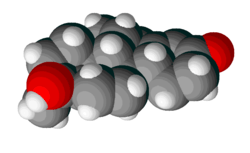Mibolerone
 | |
 | |
| Clinical data | |
|---|---|
| AHFS/Drugs.com | International Drug Names |
| Routes of administration | Oral |
| ATC code | none |
| Legal status | |
| Legal status |
|
| Pharmacokinetic data | |
| Metabolism | Hepatic |
| Biological half-life | 2–4 hours |
| Identifiers | |
| |
| Synonyms | U-10997; CDB-904; 7α,17α-dimethyl-19-nortestosterone; 7α,17α-Dimethylestr-4-en-17β-ol-3-one |
| CAS Number |
3704-09-4 |
| PubChem (CID) | 251636 |
| IUPHAR/BPS | 2859 |
| ChemSpider |
220460 |
| UNII |
9OGY4BOR8D |
| KEGG |
D05025 |
| ChEBI |
CHEBI:34849 |
| ChEMBL |
CHEMBL425863 |
| Chemical and physical data | |
| Formula | C20H30O2 |
| Molar mass | 302.4558 g/mol |
| 3D model (Jmol) | Interactive image |
| |
| |
| | |
Mibolerone (INN, USAN, BAN) (brand names Cheque Drops, Matenon; developmental code name U-10997), also known as 7α,17α-dimethyl-19-nortestosterone (DMNT),[1] is a potent, orally active anabolic-androgenic steroid (AAS) and 17α-alkylated derivative of nandrolone (19-nortestosterone) that was marketed by Upjohn for use as a veterinary drug.[2][3] It was indicated as an oral treatment for prevention of estrus (heat) in adult female dogs.[2] Mibolerone is the 17α-methyl derivative of trestolone (7α-methyl-19-nortestosterone; MENT).[1] It has both higher affinity and greater selectivity for the androgen receptor (AR) than does the related potent AAS metribolone (17α-methyl-19-nor-δ9,11-testosterone),[4][5] although potent and significant progestogenic activity remains present.[1] However, another study found that mibolerone and metribolone had similar affinity for the progesterone receptor (PR) but that mibolerone only had around half the affinity of metribolone for the AR.[6]
Chemistry
Synthesis
Nandrolone (1) appears to be used to make mibolerone. For comparison, also see bolasterone and calusterone. The first step involves extending the conjugation of the enone function by an additional double bond. Chloranil (tetrachloroquinone) is the forerunner of dichlorodicyanoquinone (DDQ), a reagent used extensively for introducing additional unsaturation in the progestin and corticoid series.

In the case at hand, heating acetate (1) with chloranil gives the conjugated dieneone (2), and reaction of that compound with methylmagnesium bromide in the presence of cuprous chloride leads to addition of the methyl group to position 7 at the end of the conjugated system (3). The stereochemistry of the product again illustrates the preference for additions from the backside. The alcohol at C17 is then oxidized to a ketone (4). Enamines are commonly used to activate adjacent functions; they are also not infrequently used, as in this case, as protecting groups. Thus, reaction of the intermediate with pyrrolidine gives dienamine (5). This transformation emphasizes the clear difference in reactivity between ketones at C7 and C17. A second methyl Grignard addition gives the corresponding 17α-methyl derivative. Hydrolysis of the enamine function then affords mibolerone (6).
The same structure of 3 and 4 also containing an 11β-fluoro group has also been described in the patent literature.[7]
See also
References
- 1 2 3 Markiewicz L, Gurpide E (1997). "Estrogenic and progestagenic activities of physiologic and synthetic androgens, as measured by in vitro bioassays". Methods Find Exp Clin Pharmacol. 19 (4): 215–22. PMID 9228646.
- 1 2 J. Elks (14 November 2014). The Dictionary of Drugs: Chemical Data: Chemical Data, Structures and Bibliographies. Springer. pp. 822–. ISBN 978-1-4757-2085-3.
- ↑ Index Nominum 2000: International Drug Directory. Taylor & Francis. January 2000. pp. 689–. ISBN 978-3-88763-075-1.
- ↑ Murthy LR, Johnson MP, Rowley DR, Young CY, Scardino PT, Tindall DJ (1986). "Characterization of steroid receptors in human prostate using mibolerone". Prostate. 8 (3): 241–53. doi:10.1002/pros.2990080305. PMID 2422638.
- ↑ Schilling K, Liao S (1984). "The use of radioactive 7 alpha, 17 alpha-dimethyl-19-nortestosterone (mibolerone) in the assay of androgen receptors". Prostate. 5 (6): 581–8. doi:10.1002/pros.2990050603. PMID 6333679.
- ↑ Loughney DA, Schwender CF (1992). "A comparison of progestin and androgen receptor binding using the CoMFA technique". J. Comput. Aided Mol. Des. 6 (6): 569–81. PMID 1291626.
- ↑ U.S. Patent 7,361,645 (2008 to Bayer Schering Pharma Ag).